Aglaophyton
branching
Drawings showing the overall aspect of Aglaophyton
(former name Rhynia major), including repeatedly
re-drawn versions, are
available in great variety. The early ones [1] are far from reality but
are
still offered occasionally as if they depicted the real thing. Others
seem to
have been inspired by the simplest thinkable option explaining the
observed
undulating growth mode, according to which the shoot grew upwards until
it fell
over under its own weight, touched the ground with its tip, grew
rhizoids
there, then turned upwards again [2]. However, the falling-over part of
this
alleged sequence of events is erroneous and has been
replaced by the assumption of downward growth [3].
The idea proposed in [2] that essentially there is no morphological
difference between undulating and upright axes, based on the
observation that both have got stomata and look alike in cross-section,
seems to come closer to reality than the
differentiation between "rhizomatous" and upright axes in [4].
The branching in other published drawings of this species varies
between narrowly V-shaped with very small angle of divergence and
broadly U-shaped as it really is. Characterizing the U-shape as
"dichotomous branching with an angle of dichotomy between 60° and 90° "
[4] does not immediately make sense since it is not obvious what is
meant by "angle
of a U-shape", not counting the 180° at the bottom of the U and 0°
farther up. In view of the confusingly
different notions it seems
appropriate to consider the subject once more.
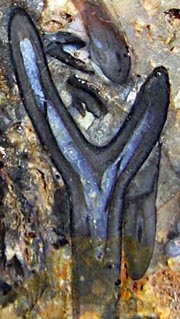
Fig.1: In-plane section of forking upright axis of Aglaophyton, hollow
inside, seen on a naturally smoothed fracture
face of an old chert layer fragment.
A well-shaped fork is a
rare sight among the abundant sections of Aglaophyton seen
on the surface or on cut faces of Rhynie chert samples, the reason of
which is obvious: In order that a fork is seen as such on a smooth
face, the latter would have to approximately
coincide with one of the two symmetry planes of the fork, which would
be a rare coincidence.
The fork in Fig.1 is not quite perfectly seen
since its prongs get out of the sample surface before they become
parallel, so the section looks more like the letter Y. Also the forking
xylem strand is not seen here. Incidentally
the plant was partially hollow before
silicification, hence the forking light-coloured streak inside.
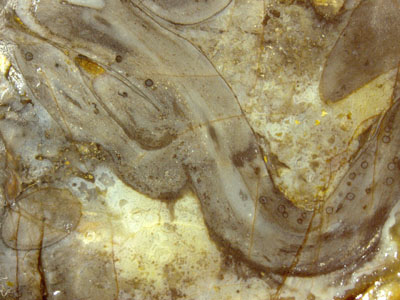
Fig.2 (right): Two lateral branches on an upward-bent
Aglaophyton
axis seen on a naturally smoothed fracture face of an
old fragment of a chert layer of 6cm thickness. Width of the picture
20mm.
It appears that forking and downward growth are
not the only
means of
spreading which are available to Aglaophyton.
The seldom seen lateral branching is another option [5]. An uncommon
example with two lateral
branches growing in the same direction,
apparently from lateral buds positioned close together on the main
axis, is shown in Fig.2.
Fig.3,4 (below): Aglaophyton
branching site and related drawing,
detail of Fig.2. Note the narrow attachment site without abscission
tissue and the inclined lengthwise section of the central strand of the
main axis without any indication of xylem branching
off into
the lateral branches. Width of
the main axis 4mm.
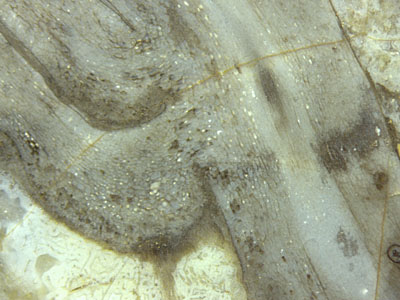
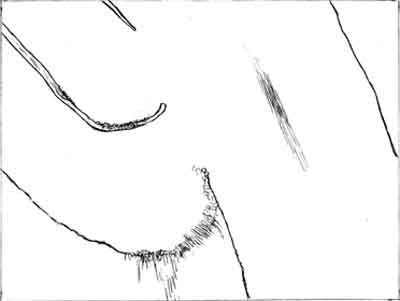
The xylem strand in Figs.2-4 is seen to keep perfectly straight at the
site of lateral branching, from which it can be concluded that there is
no hidden part of xylem branching off and entering into the
lateral
branches. Hence, the lateral branches have to
develop their xylem strand anew, which means that
the lateral branching of Aglaophyton
is fundamentally different from forking.
Small tufts of rhizoids are seen on the main axis in Fig.1 and on the
lower branch. There are rhizoids on the upper branch, too, but not
seen clearly. For lack of space they grow also along the gap between
the
branches (Fig.5). This peculiar arrangement with an evenly spaced gap
is most probably incidental and would not be worth mentioning if it did
not suggest a conclusion: Rhizoid growth is not necessarily triggered
by contact with soil. It seems to be coupled to the onset of upward
growth at the lowermost point of an axis or branch.
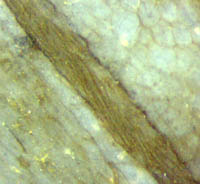
Fig.5 (right): Aglaophyton
rhizoids grown along the gap between closely
spaced lateral branches,
detail of Fig.3. Gap width 0.16mm.
The narrow attachment area between the main axis and the branches, the
absence
of a conducting strand leading into the branches, and the rhizoids at
the beginning of every branch make the branches appear like propagules.
The absence of an abscission
tissue seems to indicate that the branches are not made for breaking
off
and being carried away by wind and water but for proliferation on the
spot.
Conclusions drawn from the fossil evidence presented here and elsewhere
partially confirm or contradict existing views. They can
be summarized as follows:
(1) The idea of Aglaophyton growing upwards only, thereby forking, falling over, growing rhizoids when the tip touches the ground [2], is not
true.
(2) Aglaophyton does
not fall over but can actively change growth from upward to downward
[3].
(3) It may grow lateral branches from buds not connected to the
central strand [5].
(4) Rhizoid growth is not
necessarily triggered by contact with the ground.
The hollow fork in Fig.1 provides a connection to a quite different
observation. The cavity inside Aglaophyton
is obviously
due to some kind of damage to the tissue. The damage has been ascribed
to shrinkage or decay of the dead plant part [4]. This may sometimes or
often really
apply to the observed cavities but there must be other causes, too.
Peculiar arrangements of cavities in Aglaophyton
which cannot be explained by mere shrinkage or decay must have been
present in the living plant, thus being manifestations of misguided
growth [6].
Such conclusion is suggested by the existence of equal void
patterns in the prongs of a fork, which could not reasonably have
formed independently but must have been inherited from the stem below
the fork [7].
Compatible with this idea although less convincing than the
mentioned examples [6,7] is Fig.1 showing an apparently
even-shaped cavity forking along with the stem.
H.-J. Weiss
2013 2015
[1] R.
Kidston, W.H. Lang
: On Old Red Sandstone plants
showing structure, from the Rhynie Chert bed, Part IV,
Trans. Roy. Soc. Edinburgh 52(1921),
831-54.
[2] David
S. Edwards, Aglaophyton
major, a non-vascular land-plant from the Devonian Rhynie
Chert,
Bot. J. Linn. Soc. 93(1986), 173-204.
[3] www.chertnews.de , Rhynie
Chert News 14
[4] www.abdn.ac.uk/rhynie
[5] W.
Remy, H. Hass: New information on gametophytes and
sporophytes of Aglaophyton
...,
Rev. Palaeobot. Palyn. 90(1996),
175-93.
[6] www.chertnews.de , Rhynie
Chert News 4
[7] www.chertnews.de , Rhynie
Chert News 21
 |
 |
52 |








